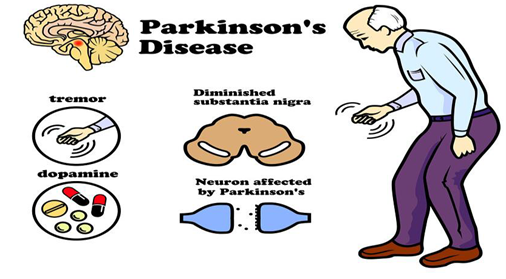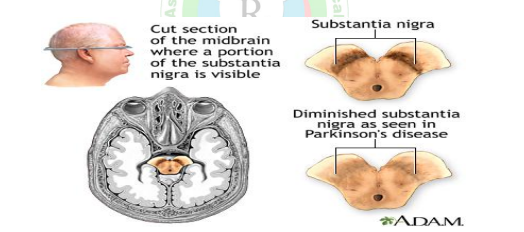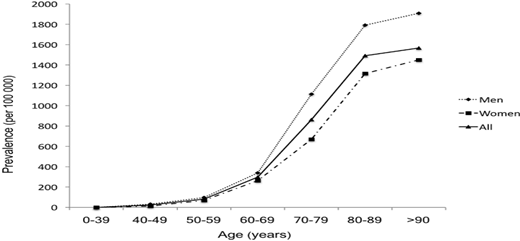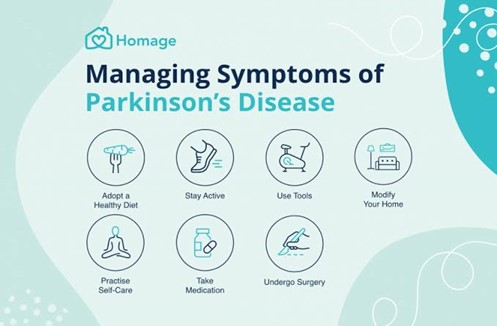Abstract
Parkinson's disease is a progressive disorder that affects movement, caused by a decrease in dopamine in the brain and an increase in acetylcholine. Symptoms include slow movements, tremors, balance issues, and loss of smell. While there’s no cure, treatment focuses on managing symptoms with medications like levodopa and dopamine agonists. Neurologists diagnose and treat the condition, and finding molecular biomarkers is crucial for distinguishing it from other disorders. Risk factors include exposure to certain chemicals, but interestingly, nicotine, caffeine, and hormone replacement therapy may offer some protective effects. Surgical options like deep brain stimulation can also help with symptom management.
Keywords
Parkinson Disease, treatment, management.
Introduction
Parkinson's disease is a chronic neurodegenerative disorder that affects movement due to a lack of dopamine in the brain, particularly in the basal ganglia. Common symptoms include slow movements, muscle stiffness, tremors, and non-motor issues like constipation. It primarily affects about 1% of people over 60 and progresses over time, impacting quality of life. Most cases have no known cause, but around 10% are linked to genetics. Diagnosis involves reviewing medical history, symptoms, and physical exams, with imaging tests like SPECT scans used if needed. Early diagnosis is crucial for managing symptoms effectively.
Background:
Parkinson's disease is a brain disorder that affects movement, first described by Dr. James Parkinson in 1817. It primarily affects older adults, usually starting after age 60, but can also occur in younger people. The disease results from the gradual breakdown of nerve cells in the substantial nigra, which produce dopamine, a chemical that helps control movement. As dopamine levels drop, symptoms like tremors, stiffness, and slowness worsen over time, making daily tasks more challenging. While the exact cause is unclear, it likely involves a mix of genetic and environmental factors, with about 10% of cases linked to inherited changes. Despite being progressive, treatments are available to manage symptoms and improve quality of life, and research continues to explore

PATHOLOGY
The pathology of Parkinson's disease involves several changes in the brain that lead to its symptoms: Cell Loss: The main issue is the loss of brain cells in the substantial nigra, which produces dopamine. By the end stage of the disease, 50-70% of these neurons are lost.
Early Changes:
Initial damage occurs in areas like the medulla oblongata and olfactory bulb, often without noticeable symptoms (Braak stages 1 and 2).
Progression: As the disease advances to stages 3 and 4, more brain regions are affected, including the midbrain, basal forebrain, and eventually the neocortex, which handles higher-level thinking.
Lewy Bodies:
Abnormal protein clumps called Lewy bodies, primarily made of alpha-synuclein, disrupt normal brain cell function and contribute to cell death.
Impact on Function:
The loss of dopamine leads to classic symptoms like tremors, stiffness, and movement slowness, as well as affecting mood, cognition, and overall quality of life as the disease progresses.
ETIOLOGY
The etiology of Parkinson's disease involves several factors that may contribute to its development:
- Genetic Factors:
Some cases are linked to specific genetic mutations, which can increase risk, particularly in families. Common genetic variants may also slightly raise the likelihood of developing the disease.
- Environmental Factors:
Exposure to toxins, such as pesticides and herbicides, along with air pollution and heavy metals, is associated with a higher risk of Parkinson's.
- Age:
Age is a significant risk factor, with most cases occurring in individuals over 60
- Inflammation:
Chronic brain inflammation may contribute to the degeneration of neurons involved in Parkinson's.
- Head Injuries:
Significant head trauma, like that from sports or accidents, may increase the risk of developing the disease later in life.
- Loss of Dopamine:
The primary issue in Parkinson's is the loss of neurons that produce dopamine, which is essential for movement control. In summary, Parkinson's disease likely arises from a combination of genetic, environmental, and age-related factors, and understanding these elements may help improve prevention and treatment strategies.
PATHOGENISIS
:In New Jersey, many people from Italian families have been diagnosed with Parkinson's disease, which is mainly linked to the buildup of the protein alpha-synuclein in the brain. This buildup occurs in the substantial nigra, leading to the death of important brain cells and a decrease in dopamine, essential for movement control. A significant characteristic of the disease is the loss of neurons in the substantial nigra, especially in the pars compacta, where 50-70% of neurons can be lost by the time symptoms are noticeable.

In Parkinson's disease, early changes start in the medulla oblongata and progress through various stages. In the initial stages (Braak stages 1 and 2), symptoms may arise before advancing to stages 3 and 4, which impact the midbrain and substantial nigra, eventually reaching the neocortex. A key feature is the buildup of Lewy bodies, which are clusters of the protein alpha-synuclein, along with heat shock proteins that help manage these deposits. Mutations in the Parkin protein, which breaks down unwanted proteins, can also contribute to the disease. Lewy bodies are present in both Parkinson's and dementia but are not exclusive to either. Initially, Lewy bodies appear in the olfactory bulb , leading to early symptoms like changes in taste and smell, signaling nerve dysfunction
EPIDEMILOGY:
Parkinson’s disease is fairly common in industrialized countries, affecting about 0.3% of the overall population and around 1% of people over the age of 60. It can affect people of all ethnic backgrounds, but men are slightly more likely to develop the disease. In one study, it was found that about 13 new cases of Parkinson's occur per 100,000 people each year. The average age at which Parkinson’s typically starts used to be thought of as the late 50s, but now it’s believed to be in the early to mid-60s. There are also younger people who develop Parkinson's. In those with young-onset Parkinson’s, symptoms can begin between the ages of 21 and 40, and sometimes up to age 50. In rare cases, juvenile-onset Parkinson’s occurs, with symptoms starting before the age of 20. Around 5-10% of people with Parkinson’s have the young-onset form of the disease.

MANAGEMENT OF PARKINSON DISEASE
After diagnosing Parkinson's disease (PD), it's crucial for doctors to explain the diagnosis to patients and their families, as some may need time to adjust. Connecting patients with Parkinson's nurse specialists and support groups can be helpful. Starting medication can be challenging, especially early on when symptoms may be mild. Treatment decisions should involve the patient and weigh symptom severity against potential side effects. While current treatments focus on relieving symptoms, there are no therapies to protect the brain. The goal is to reduce symptoms, help patients maintain independence, and choose medications that are easy to tolerate. Success is measured by minimal side effects, noticeable symptom reduction, and the ability to live actively and productively.

CONSIQUENCE OF PARKINSON’S DISEASE: Parkinson's disease affects both motor and non-motor functions, leading to several key consequences:
Motor Symptoms:
Patients may experience tremors, stiffness, slowness of movement, and balance issues, significantly impacting daily activities.
Cognitive Impairments:
Some may face cognitive decline, including memory problems and difficulty concentrating, and in some cases, dementia.
Emotional Changes:
Common emotional issues include anxiety, depression, and apathy, which can diminish quality of life.
Sleep Disturbances:
Many individuals suffer from insomnia and other sleep disorders, like restless legs syndrome.
Autonomic Dysfunction:
This can result in blood pressure fluctuations, digestive issues, and urinary problems.
Social and Occupational Impacts:
As symptoms worsen, individuals may struggle to maintain jobs and social connections, leading to isolation.
CONCLUSION
Parkinson’s disease (PD) is one of the most common neurodegenerative disorders. It involves the abnormal buildup of proteins in certain neurons, leading to their dysfunction and eventual death. This process is influenced by a combination of genetic and environmental factors. Diagnosing Parkinson’s requires careful evaluation, as it is primarily based on clinical symptoms. Healthcare providers should remain vigilant to rule out other possible causes of the symptoms. Currently, there are various medications and surgical options available to manage both the early and late stages of the disease. As awareness of Parkinson’s disease grows, so does research into its diagnosis and treatment. Future studies are expected to focus on developing disease-modifying drugs that not only alleviate symptoms but also provide protection to neurons, potentially slowing disease progression.
REFERENCE
- Goetz CG. The history of Parkinson’s disease: early clinical descriptions and neurological therapies. Cold Spring Harb Perspect Med 2011; 1: a008862.
- Gibb WR, Lees AJ. The relevance of the Lewy body to the pathogenesis of idiopathic Parkinson’s disease. J Neurol Neurosurg Psychiatry 1988; 51: 745–52.
- 3 .Marras C, Lang A. Parkinson’s disease subtypes: lost in translation? J Neurol Neurosurg Psychiatry 2013; 84: 409–15.
- .Jankovic J, McDermott M, Carter J, et al. Variable expression of Parkinson’s disease: a base-line analysis of the DATATOP cohort. The Parkinson Study Group. Neurology 1990; 40: 1529–34.
- Khoo TK, Yarnall AJ, Duncan GW, et al. The spectrum of nonmotor symptoms in early Parkinson disease. Neurology 2013; 80: 276–81.
- Hughes AJ, Daniel SE, Ben-Shlomo Y, Lees AJ. The accuracy of diagnosis of parkinsonian syndromes in a specialist movement disorder service. Brain 2002; 125: 861–70.
- Mark MH. Lumping and splitting the Parkinson plus syndromes: dementia with Lewy bodies, multiple system atrophy, progressive supranuclear palsy, and cortical-basal ganglionic degeneration. Neurol Clin 2001; 19: 607–27.
- Rajput AH. Frequency and cause of Parkinson’s disease. Can J Neurol Sci 1992; 19 (1 suppl): 103–0
- de Rijk MC, Launer LJ, Berger K, et al. Prevalence of Parkinson’s disease in Europe: a collaborative study of population-based cohorts. Neurology 2000; 54 (11 suppl 5): S21–23.
- Baldereschi M, Di Carlo A, Rocca WA, et al. Parkinson’s disease and parkinsonism in a longitudinal study: two-fold higher incidence in men. Neurology 2000; 55: 1358–63
- 6 Martinez-Martin P, Rodriguez-Blazquez C, Kurtis MM, Chaudhuri KR, NMSS Validation Group. The impact of non-motor symptoms on health-related quality of life of patients with Parkinson’s disease. Mov Disord 2011; 26: 399–406.
- Elbaz, A., and Tranchant, C. (2007). Epidemiologic studies of environmental exposures in Parkinson’s disease. Neurol. Sci. 262, 37– 44. doi: 10.1016/j.jns.2007.06.024
- Estupinan, D., Nathoo, S., and Okun, M. S. (2013). The demise of Poskanzer and Schwab’s influenza theory on the pathogenesis of Parkinson’s disease. Parkinsons Dis. 2013:167843. doi: 10.1155/2013/167843
- Ehgoetz Martens K A, Shine J M, Walton C C, Georgiades M J, Gilat M, Hall J M, Muller A J, Szet oJ Y Y, Lewis SJG, Evidence for subtypes of freezing of gait in Parkinson's disease. Movement disorders : official journal of the Movement Disorder Society. 2018 JulY
- ChungS J, Yoo H S, Lee H S, Oh J S, Kim J S, Sohn Y H, Lee PH, The Pattern of Striatal Dopamine Depletion as a Prognostic Marker in De Novo Parkinson Disease. Clinical nuclear medicine. 2018 Aug 27
- Gratton C, Koller J M, Shannon W, Greene D J, Snyder A Z, Petersen S E, Perlm utterJS,Campbell MC, Emergent Functional Network Effects in Parkinson Disease. Cerebral cortex (New York, N.Y. : 1991). 2018 Jun 6
- Braak H, Bohl JR, Müller CM, et al. Stanley Fahn Lecture 2005: The staging procedure for the inclusion body pathology associated with sporadic Parkinson's disease reconsidered, MovDisord, 2006, vol. 21 (pg. 2042-2051)
- Chung KK, Zhang Y, Lim KL, et al. Parkin ubiquitinates the alphasynuclein-interacting protein, synphilin-1: implications for Lewy-body formation in Parkinson disease, Nat Med, 2001, vol. 7 (pg. 1144-1150)


 Vaibhav Deshpande*
Vaibhav Deshpande*
 Komal Chavan
Komal Chavan
 Kavita Kulkarni
Kavita Kulkarni




 10.5281/zenodo.13957175
10.5281/zenodo.13957175